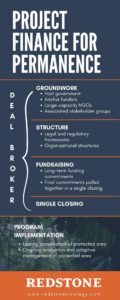Conservation deals are at the root of Redstone’s founding nearly 20 years ago. Working with clients and partners including the Linden Trust for Conservation, the Gordon and Betty Moore Foundation, and the World Wildlife Fund, Redstone’s first project used a Project Finance for Permanence (PFP) approach to establish the Amazon Rainforest Protected Area (ARPA). To this day, ARPA for Life is the largest tropical forest conservation program in history, providing permanent protection of over 60 million hectares in the Brazilian Amazon.
PFPs require several years of intensive work, typically unfolding over four stages. Unique to PFP coalitions are long-term pledges by key players to fund the conservation effort in perpetuity, with all commitments coming to fruition in a single defining close. Below we share experiences from ARPA to describe and illuminate a high-level overview of each stage.

Laying the groundwork – goal setting
To initiate the PFP process, key elements require identifying shared goals and essential partners up front. With alignment centered on a shared vision, typically a host government, a high-capacity NGO, and an anchor funder work together to determine program goals, relying on heavy ecological, financial, organizational, political, and social analysis, and stakeholder engagement.
ARPA’s groundbreaking public-private conservation effort was launched after the president of Brazil pledged to protect ten percent of Brazil’s Amazon biome in 1988. The government then worked with the World Wildlife Fund, the German Development Bank, and the World Bank/Global Environment Facility, as well as the Linden Trust for Conservation, The Gordon & Betty Moore Foundation, and the Margaret A. Cargill Foundation, to propel the initiative towards its ambitious goals of raising approximately $240 million to protect 50 million hectares. Since the initial launch, amounts have increased for both protected acreage and funds raised.
Designing the deal structure
Next, participants establish a timeline and design the deal structure required to achieve program goals, along with any legal and regulatory frameworks required to implement the project. This includes steps such as creating a conservation trust fund within a new or existing nonprofit, creating new government agencies or roles, and/or passing any legislative commitments needed to support protected area management.
The PFP model relies on a “single closing” – a defined moment at which all commitments become binding at the same time. This approach reduces the risk for participants by attracting larger commitments, mitigating the risk of half-finished projects, and building urgency to drive the project to fruition.
The ARPA coalition pioneered the PFP model by integrating long-term financial planning into the program design process, committing up-front to fund the full amount needed for ongoing conservation. The early phases of ARPA revealed that multiple factors must be considered to facilitate long-term project management, such as translating outcome-based financial plans to reconcile with government line-item budgeting and ensuring program resilience through adaptive management that incorporates social and economic concerns.
Fundraising for the full cost
With a shared objective, the coalition gathers funding commitments to cover the entire project’s costs, pulling all elements into alignment at the single closing. The lead NGO typically spearheads the fundraising effort, in tandem with a highly visible anchor funder to establish project credibility and foster philanthropic connections. The host government commonly provides most of the funding, fortified by private funding to ensure program perpetuity, in addition to financing development of the PFP itself. The single closing all-or-nothing deal structure drives urgency and magnifies each funder’s contribution. At the closing, all commitments are binding, and the program launches implementation.
ARPA was structured with distinct fundraising phases with a partial closing for each phase. However, thorough subsequent PFPs it is now recognized that a phased approach can dilute the urgency and should be avoided if possible.
Implementing the program
With all elements in place at the deal closing, the program is handed off to a party “on the ground” for implementation. At this point, the PFP has laid out organizational and ecological conditions for the program to successfully execute and adapt to meet program goals.
ARPA is managed by the Brazilian Biodiversity Fund, FUNBIO, with a focus on adaptive management to ensure program resilience. Since the program was first initiated, FUNBIO has adjusted the program to incorporate sustainable use reserves, recognizing the need for increased societal benefits. Moving forward, FUNBIO continues to support the sustainability of ARPA, while reducing threats to biodiversity and strengthening policies and plans for conservation.
Conserving for the future
The PFP model ushered in major innovations in conservation practices. By incorporating vast swaths of ecological areas, structuring multi-stakeholder involvement, and enlisting external funding aligned on a single close, PFPs enable larger-scale, longer term, and more transformative social and environmental impact. “Thinking big can pay off,” observes Roger Ullman of the Linden Trust for Conservation.
Over the years, Redstone has supported similar coalitions to conserve areas in the Great Bear Rainforest in British Columbia, marine and terrestrial regions across Costa Rica, Peru’s Natural Protected Areas, and others while continuing to refine and evolve the PFP model. Redstone teams play a vital role in the PFP process, often serving as an “honest broker” with a primary interest in seeing a deal reached and propelling the project forward by providing analytic support, mediating between the parties, ensuring all relevant constituencies are engaged, synthesizing discussions, and proposing options for discussion and decisions at periodic working group meetings. We are proud to serve our government, NGO, and philanthropic partners as they undertake substantial challenges requiring skilled and purposeful coordination.
For a deeper dive on PFP, you can read our study on PFP, review this article in the Stanford Social Innovation Review, or contact us.